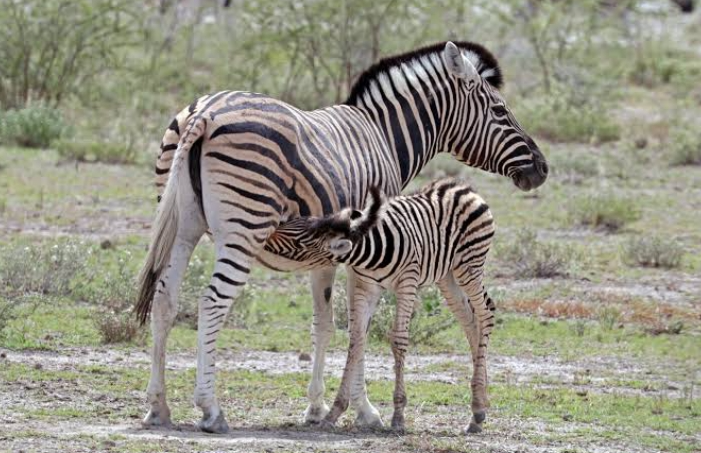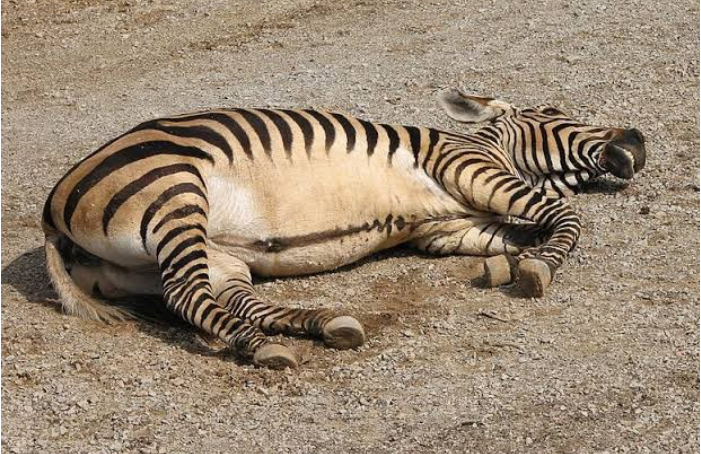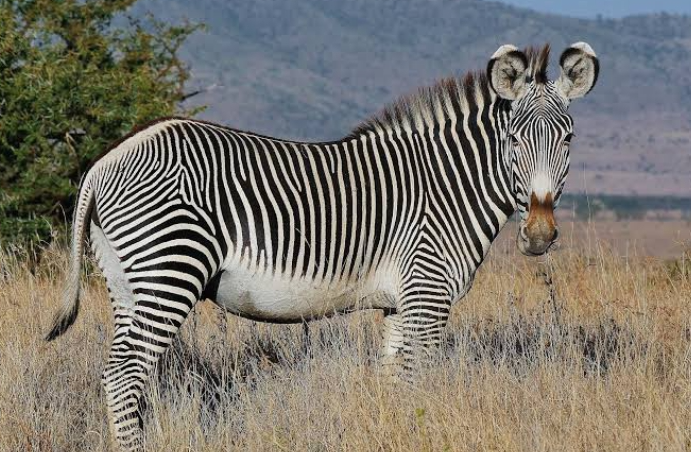Zebras are iconic members of the family (Equidae) which includes horses and donkeys. They are easily recognizable from their distinctive black and white stripes which extend from their head to their hooves. These stripes can vary in width and pattern among the different zebra species.
They are native to the plains, savannas, grasslands and open woodlands of Africa, in other words, they are only found in Africa. Their distribution depends on the species, with different species of zebras occupying different regions of the continent.
Zebras share several physical characteristics with their relatives (Donkey and Horse). They have sturdy bodies supported by four slender legs, each ending in a single, cloven hoof. They also have a short erect mane that runs down along their neck, which is usually erect and stands out prominently.
Their ears are mobile and can swivel independently, allowing them to detect sounds and communicate with other members of their herd. Zebras also have a distinctive elongated face with large, expressive eyes, and they can display a range of facial expressions, especially when communicating with other zebras.
Zebras show variations in size and physical characteristics depending on their species. These variations in size and physique reflect their adaptations to their respective habitats. Like other members of the horse family, zebras have hooves that are adapted for running and grazing. Their hooves are hard and durable, allowing them to cover long distances in their grassland habitats.
In addition to their striped coat, zebras have a long, tufted tail that ends in a black tassel. The tail’s tuft differs in appearance from the tails of other equines. The tail is used to swat away insects, particularly flies and other bothersome pests.
The coloration of zebras’ stripes and their overall coat patterns can also vary significantly between species. There are many debates and theories as to why Zebras have stripes or unique pattern of stripes, just like a human fingerprint. Some scientists think this is so that they can recognise each other. But most theories agree that zebras have stripes to create an optical illusion for predators.
Zebras are social animals and are often seen in groups called “dazzles” or “harems.” These groups provide protection from predators, as there are more eyes to watch for danger. The dominant male in a harem typically defends his territory and mates.
They are herbivores, primarily grazing on grasses. Their digestive system is adapted for processing plant material, and they spend a significant portion of their day feeding.
Zebras reproduce sexually, and a single foal is born after a gestation period of around 12 to 13 months. The young zebras are called foals, and they can stand and walk shortly after birth. They are protected by the group.
In their African habitats, Zebras face a number of predators. At the top of the list are lions, which hunt zebras both individually and in coordinated groups. Hyenas also with their scavenging tendencies and ability to overpower injured or young zebras. Crocodiles pose a lurking danger during river crossings, ambushing zebras as they traverse waterways. Leopards and cheetahs may target isolated or weakened zebras, while African wild dogs are agile and persistent pursuers.
Zebras, like many African wildlife species, face threats from habitat loss and poaching. Conservation efforts are in place to protect these animals and their habitats. Some zebras are classified as vulnerable or endangered, particularly Grevy’s zebras, which have a much smaller population compared to the other species.
Types or Species of Zebra
There are three primary species of zebras:
- Plains Zebra (Equus quagga)
- Mountain Zebra (Equus zebra)
- Grevy’s Zebra (Equus grevyi)
Plains Zebra (Equus quagga)

The plains zebra, also known as the common zebra is the most common and widespread species of zebra. It is characterized by its black and white stripes, which are often seen in a bold pattern. The black and white stripes cover its entire body, including the head, body and legs. Its range is fragmented, but spans much of southern and eastern Africa south of the Sahara.
Plains Zebras are medium-sized animals. They typically stand about 1.2 to 1.4 meters (4 to 4.6 feet) tall at the shoulder and have a body length of around 2.3 to 2.7 meters (7.5 to 8.9 feet). Adult Plains Zebras can weigh between 220 to 350 kilograms (485 to 770 pounds), with males generally being larger and heavier than females.
Plains Zebras have a short, erect mane along their necks, similar to that of a horse. The mane can sometimes be different in color but is dark, matching the black stripes on their bodies.
Within the plains zebra category, there are several subspecies, which include:
Six or seven subspecies have been recognised, including the extinct quagga which was thought to be a separate species. More recent research supports variations in zebra populations being clines rather than subspecies.
Burchell’s Zebra (Equus quagga burchellii)
Burchell’s zebra is one of the most widespread and commonly recognized subspecies of Plains Zebra. It is named after the British explorer and naturalist William John Burchell.
It has bold, black stripes on a white background, and its range extends across various regions of southern and eastern Africa. Burchell’s zebra is the only subspecies of zebra which may be legally farmed for human consumption
Grant’s Zebra (Equus quagga boehmi)
Grant’s zebra is found in East Africa, particularly in countries like Kenya and Tanzania (Serengeti-Mara ecosystem). It is the smallest of the seven subspecies of the plains zebra. It has narrower and more numerous stripes compared to some other subspecies, and its belly often lacks stripes.
Selous’ Zebra (Equus quagga selousi)
Selous’ zebra is a subspecies found in southwestern Tanzania and mostly in Mozambique. It has a unique stripe pattern characterized by faint or shadow stripes between the bold black stripes.
These subspecies have clean black-and-white banding without the brown shadow stripes of the Chapman’s zebra subspecies. These are extended down the flanks and over the whole body except face and neck. The upper half is covered with horizontal stripes, mostly faded, that do not go around the legs. The belly is partly striped.
Chapman’s Zebra (Equus quagga chapmani)
Chapman’s zebra is found in southern Africa, in countries like Zambia, Zimbabwe, and Mozambique. It has a relatively bold and wide stripe pattern.
Crawshay’s Zebra (Equus quagga crawshayi)
This subspecies is native to the eastern region of Zambia and Angola. It is named after its describer James Chapman. It is known for having broader and less numerous stripes compared to some other Plains Zebra subspecies.
When compared to other equids in the region Chapman’s zebras are relatively abundant in number, however its population is now in decline largely because of human factors such as poaching and farming
Cape Mountain Zebra (Equus zebra zebra)
Although technically a subspecies of the Mountain Zebra (Equus zebra), the Cape Mountain Zebra is closely related to Plains Zebras. It is found in the mountainous regions of the Western and Eastern Cape provinces of South Africa. It is the smallest of all existing zebra species and also the most geographically restricted. It is characterized by its reduced stripe pattern.
Although once nearly driven to extinction, the population has now been increased by several conservation methods, and is classified as Vulnerable by the IUCN.
The maneless zebra (Equus quagga borensis)
It ranges in northwestern Kenya (from Uasin Gishu and Lake Baringo) to the Karamoja district of Uganda. It is also found in eastern South Sudan, east of the White Nile (for example, in Boma National Park). It is the northernmost subspecies of the plains zebra. The last remaining substantial population is in Kidepo Valley National Park.
Mountain Zebra (Equus zebra)

Mountain zebras are native to southern Africa and are adapted to living in hilly and mountainous terrain. They have a more controlled and less pronounced stripe pattern compared to other zebra species. They usually have vertical stripes on the neck and torso, which may extend to the legs. Unlike Plains Zebras with bold black and white stripes, Mountain Zebras have narrower and more closely spaced stripes.
The belly of this Zebra lacks stripes and is white or pale in color, which is a distinguishing feature from Plains Zebras that often have stripes extending to the belly. Like other zebras, Mountain Zebras have relatively big, round ears that can swivel to detect sounds from different directions.
Mountain Zebras are smaller than Plains Zebras and Grevy’s Zebras. They stand around 1.1 to 1.3 meters (3.6 to 4.3 feet) tall at the shoulder and have a body length of approximately 2.2 to 2.5 meters (7.2 to 8.2 feet). Adult Mountain Zebras can weigh between 250 to 360 kilograms (550 to 790 pounds).
Mountain Zebras have a short, erect mane along their necks, which is dark, matching the color of their stripes.
There are two subspecies of mountain zebras: the Cape mountain zebra and the Hartmann’s mountain zebra.
Cape Mountain Zebra (Equus zebra zebra)
Also known simply as the Cape Mountain Zebra, this subspecies is found in South Africa and primarily inhabits the mountainous regions of the Cape Province. It is characterized by a relatively small and compact body size and a distinct stripe pattern. The Cape Mountain Zebra is recognized for its conservation success story, as its population has increased in recent years due to conservation efforts.
Hartmann’s Mountain Zebra (Equus zebra hartmannae)

Hartmann’s Mountain Zebra is found in Western Namibia and southwestern Angola. It is easily distinguished easily from other similar zebra species by its dewlap as well as the lack of stripes on its belly. It is also slightly larger in size compared to the Cape Mountain Zebra and a stripe pattern that is somewhat less pronounced and more widely spaced. It is also adapted to mountainous terrain.
Grevy’s Zebra (Equus grevyi)

Grévy’s zebra (Equus grevyi), also known as the imperial zebra, is the largest living wild equid and the most threatened of the three species of zebra.
They were named after Jules Grévy, then president of France, who, in the 1880s, was given one by the government of Abyssinia (Ethiopia).
Superficially, Grévy’s zebras’ physical features can help to identify it from the other zebra species. Unlike the bold and closely spaced black and white stripes of other zebras, Grevy’s Zebras have narrower, more numerous, and closely spaced stripes. Their ears are larger than those of other zebras, and they have a more mule-like appearance.
Grevy’s Zebras are the largest of all zebra species. They can stand at a shoulder height of around 1.4 to 1.6 meters (4.6 to 5.2 feet) and have a body length of approximately 2.5 to 3 meters (8.2 to 9.8 feet). Adult males are larger and heavier than females, with weights ranging from 350 to 450 kilograms (770 to 990 pounds).
They have a relatively narrow and pointed muzzle compared to other zebra species, which is adapted for browsing on tougher, drier vegetation in their arid habitat.
Grevy’s Zebras have long, slender legs. Their belly is white and lacks prominent stripes, which is a common feature among zebras.
Grevy’s Zebras have a tall, erect mane along their necks, which stands upright and is usually dark, often black or dark brown. This mane sets them apart from other zebras, as it is notably different in appearance.
They can go without water for up to 5 days. Mostly grazers, they live on grasses and herbaceous plants but during very dry periods they also browse.
Grevy’s zebra females are generally found together with other females in similar stages of reproduction. Females achieve sexual maturity around 3 years of age and males achieve sexual maturity around 6 years of age.
Less common than even the rhino, the Grévy’s zebra is now endangered with the total population having declined from 15,000 to under 3,000 since the 1970’s.
There are two subspecies of Grevy’s Zebra
Northern Grevy’s Zebra (Equus grevyi grevyi)

This subspecies is found in the northern part of Grevy’s Zebra’s range, primarily in Ethiopia. It has been described as having a lighter overall coloration and more pronounced striping compared to the other southern subspecies.
Southern Grevy’s Zebra (Equus grevyi hartmannae)

The southern subspecies inhabits the southern part of Grevy’s Zebra’s range, mainly in Kenya. It has been described as having darker and more extensive striping, with a slightly different appearance compared to the northern subspecies. It’s also bigger in size, stocky and stronger.